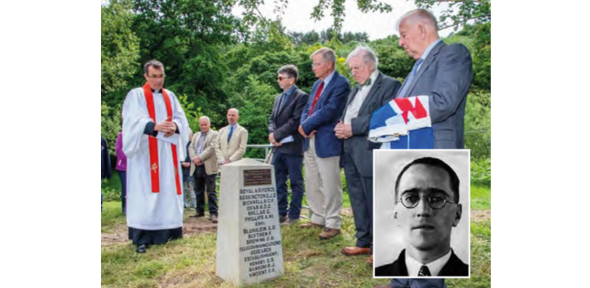
#AnniversaryStory
As part of our 150th anniversary, we remember physicists who worked with the Cavendish Laboratory and lost their lives during the war. One of these tragic events was the death of Alan Dower Blumlein, inventor of the stereo.
Halifax V9977 pictured at RAF Hurn while testing the prototype H2S.
On 7 June 1942, a Halifax bomber plane crashed near the River Wye at the small village of Welsh Bicknor in Herefordshire. The plane had been on a secret mission on behalf of the Telecommunications Research Establishment (TRE), testing a prototype of the H2S airborne radar system. The H2S was the first ground-scanning radar system, which allowed for targeted nighttime bombing. In the plane was Alan Blumlein, credited for the invention of the Stereo along with 128 patents. A brilliant inventor, Blumlein worked in the TRE along with other leading scientists including Philip Dee, a lecturer at the Cavendish.
The Butt Report, which detailed how inaccurate bombing was before the creation of the H2S and other radar, showed that only one bomb in twenty landed within 5 miles of the target, that half the bombs fell on open country, and can be as inaccurate as 50km away from the target. Therefore, Blumlein’s help in the invention of the H2S radar was vital in the development of targeted weapons. It was also key in the defence against the U-boats.
Blumlein’s death left behind his two sons, Simon (6 years old) and David (4 years old), and his wife, Doreen. Simon, being old enough to remember, often recalled the grief he felt over his father’s passing.
|
Picture of Alan & Doreen Blumlein, with kids Simon & David Blumlein. |
David Blumlein (left) and Simon Blumlein (right), holding A.D.Blumlein's pocket watch and a Union Jack at the memorial of the Halifax Bomber, 2019. |
Philip Ivor Dee CBE, FRS
Philip Ivor Dee, a nuclear physicist who worked alongside Cockroft and Rutherford in the Cavendish, was a contemporary of Blumlein’s. After Blumlein’s death, he continued work in the TRE and developed the ‘Village Inn’ radar system, which allowed for detection of enemy fighter planes in the dark and for guns to fire automatically at the target. Blumlein’s influence on radar, being the chief designer of the H2S, proved to be influential, and was no doubt an inspiration to Dee and others.
After the war, Alan Turing started work on the ACE computer, which aimed to improve the computational power compared to the previous Colossus machine in Bletchley Park. Interestingly, he credited Blumlein’s previous patents as being influential in the engineering of this work and it shows the lasting importance of Blumlein’s work.
Technical Grammy Award given to Alan Dower Blumlein posthumously
The technology invented by Blumlein and many other unsung heroes in the war is a testament to their perseverance and brilliance during an adverse period in our history. Blumlein was awarded the Technical Grammy Award in 2017 posthumously.
Main Image: The unveiling of the memorial to Blumlein and others who died in the crash, 2019. From right to left: David and Simon Blumlein, Mike Philips (co-pilot's son) and Garth Lawson. Inset: Alan Dower Blumlein
Text credit: Dhruv Shenai





